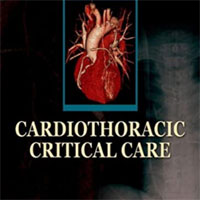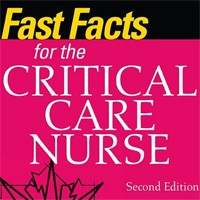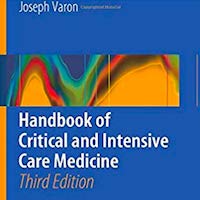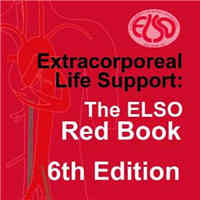Tag: hemodynamics
Expert Consensus on Methodology for Conducting and Reporting Echocardiography Research Studies
Echocardiography is a common tool for cardiac and hemodynamic assessments in critical care research. However, interpretation (and applications) of results and between-study comparisons are often difficult due to the lack... read more
Cardiothoracic Critical Care
This new bedside manual guides you through all the practical aspects of managing patients following cardiothoracic surgery and critically ill cardiology patients. Primarily designed to use in cardiothoracic intensive care... read more

Pulse Wave Analysis to Estimate Cardiac Output
Cardiac output (CO)–guided therapy is a promising approach to hemodynamic management in high-risk patients having major surgery and in critically ill patients with circulatory shock. Pulmonary artery thermodilution remains... read more
Shedding Light on a Hidden Source of Septic Shock with POCUS
Septic shock has a high mortality rate, estimated to be higher than 40% [1], increasing as time passes without appropriate treatment. Hence, correct diagnosis of the cause of sepsis is essential to provide correct antibiotic... read more
Validation of a Point-of-Care Capillary Lactate Measuring Device
Lactate Pro 2 had good agreement with the reference method using arterial blood but poorer agreement using venous blood. Our results show the potential for overestimation of the lactate values in haemodynamically compromised... read more
Inhaled Pulmonary Vasodilators
Confusion between inhaled versus intravenous routes for pulmonary vasodilators. For optimal clinical benefit (especially regarding oxygenation), these agents must be given via an inhaled route. The misconception that inhaled... read more
Cardiovascular Phenotypes in Ventilated Patients with COVID-19 ARDS
Approximately two-thirds of patients admitted to the intensive care unit (ICU) for coronavirus disease-19 (COVID-19) pneumonia present with the acute respiratory distress syndrome (ARDS). COVID-19-associated acute cardiac... read more
Difficult Bag-Mask Ventilation in Critically Ill Children Is Independently Associated With Adverse Events
Difficult bag-mask ventilation is reported in approximately one in 10 PICU patients undergoing tracheal intubation. Given its association with adverse procedure–related events and oxygen desaturation, future study is warranted... read more
How I Approach Weaning from Venoarterial ECMO
Weaning from VA-ECMO remains a challenging but critically important step in device management. The key is to balance minimizing complications associated with device support with the potential for hemodynamic deterioration... read more
Corticosteroids for Critically Ill COVID-19 Patients with Cytokine Release Syndrome
Approximately 5% of coronavirus disease (COVID-19) patients will require admission to an intensive care unit (ICU). Among these patients, the most severe cases may be mediated by a late-onset systemic inflammatory response... read more
Effects of Paracentesis on Hemodynamic Parameters and Respiratory Function in Critically Ill Patients
Paracentesis in critically ill patients is safe regarding hemodynamic function, renal function and intervention-related complications. Furthermore, paracentesis in critically ill and mechanically ventilated patients results... read more
Clinical Distancing of Patients with Advanced Heart Failure and Cardiac Transplantation During COVID-19
Our hospital system includes a central 825-bed, short term, acute care teaching facility where heart transplantation is performed under regulatory approval. Located 5.5 miles north of this main campus is a 107-bed cardiac... read more
The End-expiratory Occlusion Test
There is growing evidence that the end-expiratory occlusion (EEO) test reliably detects preload responsiveness. It is easier to perform than passive leg raising and has less limitations than pulse pressure variations, provided... read more
Fast Facts for the Critical Care Nurse
This newly updated, quick-access guide for critical care nurses covers the most common admitting diagnoses and reviews their causes, signs and symptoms, and interventions. Critical care nursing requires astute assessment,... read more

Comparison of Echocardiographic and Invasive Measures of Volaemia and Cardiac Performance in Critically Ill Patients
Static echocardiographic variables did not reliably reflect the volume state as defined by estimates of mean systemic filling pressure. There was no statistical or clinically robust relationship between static echocardiographic... read more
Guidelines for the Management of Septic Shock and Sepsis-Associated Organ Dysfunction in Children
A large cohort of international experts was able to achieve consensus regarding many recommendations for the best care of children with sepsis, acknowledging that most aspects of care had relatively low quality of evidence... read more
Artificial Intelligence or Merely a Symptom of a Broken Healthcare System?
We are constantly hunting for newer and better sources of information. This leads to a perpetual generation of newer lab tests, different hemodynamic gizmos, and fresh decision tools. Some of these pan out. Most don't. Why... read more
Microcirculation Evolution in Patients on VA-ECMO for Refractory Cardiogenic Shock
Microcirculation is severely impaired in patients with refractory cardiogenic shock requiring venoarterial extracorporeal membrane oxygenation (VA-ECMO). Inability to rapidly restore microcirculation during the first... read more
Vasopressin for Acute Hemorrhage?
Vasoactive medications are one of the pillars of management of shock in Emergency Departments. Inopressors, namely Norepinephrine and Epinephrine, are the two most commonly used pressors in US Emergency Departments, used... read more
Predicting Adverse Hemodynamic Events in Critically Ill Patients
The art of predicting future hemodynamic instability in the critically ill has rapidly become a science with the advent of advanced analytical processed based on computer-driven machine learning techniques. How these... read more
The Neurohormonal Basis of Pulmonary Hypertension in HFpEF
Subjects with heart failure with preserved ejection fraction (HFpEF) display activation of the endothelin and adrenomedullin neurohormonal pathways, the magnitude of which is associated with pulmonary hemodynamic derangements,... read more
Nonoperative Management of Splenic Injury of Patients with Reduced Consciousness is Safe and Feasible in Well-equipped Institutions
This study shows that NOM for blunt splenic trauma is a viable treatment modality in well-equipped institutions, regardless of the patients mental status. However, the presence of neurologic impairment is associated with... read more









